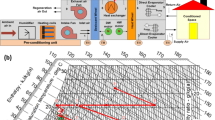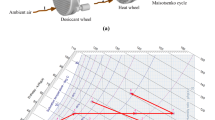Abstract
Over the past decade, different variants of desiccant cooling system integrated with direct/indirect evaporative cooler(s) have been simulated and/or analyzed in specific climatic conditions under rather limited operating parameters and for limited durations of time. Complete seasonal and multi-climate performance analyses of solar desiccant cooling system integrated with efficient, indirect Maisotsenko Cycle based evaporative cooler, having combinational installations at process and/or regeneration sides, is rarely investigated and reported. In the current work, multiple configuration variants of solar desiccant cooling system, integrated with multi-stage indirect evaporative cooling technique based on Maisotsenko Cycle, having a designed cooling capacity of 50 kW are analyzed through a model-based transient simulation approach. Simulations are carried out for a complete typical summer season in northern hemisphere, starting from April to September, using TRNSYS in three different climatic zones including subtropical humid summer (Cfa), hot desert (Bwh) and hot semi-arid (Bsh) conditions. The three selected climatic zones cover around 20% of global world map hosting more than 37% of world population. Each configuration is analyzed in terms of wet bulb and dew point effectiveness using their respective cooling techniques, system’s thermal coefficient of performance, and solar fraction for each climate zone. It is seen that the configuration using IEC at both process and regeneration sides has the highest values of coefficient of performance and solar fraction in all selected climatic zones compared to others. The respective values of coefficient of performance is 2.28 and solar fraction of 23.84% observed in Bwh while coefficient of performance of 2.03 and solar fraction of 23.33% in Cfa; and coefficient of performance of 2.12 and solar fraction of 46.86% in Bsh climatic zones are noted. The increase of solar fraction in hot and arid climates are expected compared to Cfa. While the value of coefficient of performance for such a system is significantly improved and shows promising prospects to efficiently provide thermal comfort during summer seasons.















Similar content being viewed by others
Abbreviations
- a:
-
Auxiliary
- amb:
-
Ambient
- ds:
-
Desiccant System
- dh:
-
Dehumidification
- dp:
-
Dew Point
- in:
-
Inlet
- out:
-
Outlet
- lat:
-
Latent
- p:
-
Process
- reg:
-
Regeneration
- s:
-
Solar
- sen:
-
Sensible
- w:
-
Water
- wb:
-
Wet Bulb
References
Al-Alili A, Hwang Y, Radermacher R, Kubo I (2012) A high efficiency solar air conditioner using concentrating photovoltaic/thermal collectors. Appl Energy 93:138–147
Pérez-Lombard L, Ortiz J, Pout C (2008) A review on buildings energy consumption information. Energy Build. 40(3):394–398
Shi W, Jin X, Wang Y (2019) Evaluation of energy saving potential of HVAC system by operation data with uncertainties. Energy Build 204:109513
Gadalla M, Saghafifar M (2016) Performance assessment and transient optimization of air precooling in multi-stage solid desiccant air conditioning systems. Energy Convers Manag 119:187–202
Gao W, Worek W, Konduru V, Adensin K (2015) Numerical study on performance of a desiccant cooling system with indirect evaporative cooler. Energy Build. 86:16–24
Mansuriya K, Patel VK, Raja BD, Mudgal A (2020) Assessment of liquid desiccant dehumidification aided vapor-compression refrigeration system based on thermo-economic approach. Appl. Therm. Eng. 164(April 2019):114542
Fong KF, Chow TT, Lee CK, Lin Z, Chan LS (2010) Advancement of solar desiccant cooling system for building use in subtropical Hong Kong. Energy Build. 42(12):2386–2399
Jani DB, Mishra M, Sahoo PK (2015) Performance studies of hybrid solid desiccant – vapor compression air-conditioning system for hot and humid climates. Energy Build. 102:284–292
Yamaguchi S, Jeong J, Saito K, Miyauchi H, Harada M (2011) Hybrid liquid desiccant air-conditioning system : experiments and simulations. Appl Therm Eng 31(17–18):3741–3747
Speerforck A, Schmitz G (2016) Experimental investigation of a ground-coupled desiccant assisted air conditioning system. Appl Energy 181:575–585
Beccali M, Finocchiaro P, Nocke B (2012) Energy performance evaluation of a demo solar desiccant cooling system with heat recovery for the regeneration of the adsorption material. Renew Energy 44:40–52
Su W, Zhang X (2017) Thermodynamic analysis of a compression-absorption refrigeration air-conditioning system coupled with liquid desiccant dehumidification. Appl Therm Eng 115:575–585
Elgendy E, Mostafa A, Fatouh M (2015) Performance enhancement of a desiccant evaporative cooling system using direct/indirect evaporative cooler. Int J Refrig 51:77–87
Ling J, Hwang Y, Radermacher R (2014) Desiccant-assisted cooling
Khalid A, Mahmood M, Asif M, Muneer T (2009) Solar assisted, pre-cooled hybrid desiccant cooling system for Pakistan. Renew Energy 34:151–157 Elsevier
Dizaji HS, Hu EJ, Chen L (2018) A comprehensive review of the Maisotsenko-cycle based air conditioning systems. Energy 156:725–749
Qadar Chaudhary G, Ali M, Sheikh NA, Gilani SIUH, Khushnood S (2018) Integration of solar assisted solid desiccant cooling system with efficient evaporative cooling technique for separate load handling. Appl Therm Eng 140(May):696–706
Mujahid Rafique M, Gandhidasan P, Rehman S, Al-Hadhrami LM (2015) A review on desiccant based evaporative cooling systems. Renew Sust Energ Rev 45:145–159
Heidarinejad G, Pasdarshahri H (2011) Potential of a desiccant-evaporative cooling system performance in a multi-climate country. Int J Refrig 34(5):1251–1261
Ali M, Vukovic V, Sheikh NA, Ali HM (2015) Performance investigation of solid desiccant evaporative cooling system configurations in different climatic zones. Energy Convers Manag 97:323–339
Pandelidis D, Anisimov S, Worek WM, Drąg P (2016) Numerical analysis of a desiccant system with cross-flow Maisotsenko cycle heat and mass exchanger. Energy Build. 123:136–150
Saghafifar M, Gadalla M (2016) Performance assessment of integrated PV/T and solid desiccant air-conditioning systems for cooling buildings using Maisotsenko cooling cycle. Sol Energy 127:79–95
Pacak A, Cichoń A, Pandelidis D, Anisimov S (2018) Impact of indirect evaporative air cooler type on the performance of desiccant systems. E3S Web Conf 44:00134
Kashif Shahzad M, Qadar Chaudhary G, Ali M, Ahmed Sheikh N, Shahid Khalil M, Rashid TU (2018) Experimental evaluation of a solid desiccant system integrated with cross flow Maisotsenko cycle evaporative cooler. Appl Therm Eng 128:1476–1487
Chen D, Chen HW (2013) Using the Köppen classification to quantify climate variation and change: an example for 1901–2010. Environ Dev 6:69–79
World Population Data (2019). [Online]. Available: http://worldpopulationreview.com/world-cities/
Klein SA, Beckman WA, Mitchell JW, Duffie JA, Duffie NA, Freeman BLEL, Mitchell JC, Braun JE (1988) TRNSYS-A transient system simulation program. Univ. Wisconsin-Madison, Eng Exp Stn Rep, 12–38
Ahamed MS, Guo H, Tanino K (2020) Modeling heating demands in a Chinese-style solar greenhouse using the transient building energy simulation model TRNSYS. J Build Eng 29:101114
S. A. Klein et al. 2012() TRNSYS 17 Volume 4 Mathematical Reference. SEL (Solar Energy Lab. Univ. Wisconsin-Madison), TRANSSOLAR Energietechnik GmbH, CSTB (Centre Sci. Tech. Bâtiment), TESS (Thermal Energy Syst. Spec.)
Jani DB, Mishra M, Sahoo PK (2018) Performance analysis of a solid desiccant assisted hybrid space cooling system using TRNSYS. J Build Eng 19(December 2017):26–35
Lhendup T, Lhundup S (2007) Comparison of methodologies for generating a typical meteorological year (TMY). Energy Sustain Dev 11(3):5–10
Riangvilaikul B, Kumar S (2010) An experimental study of a novel dew point evaporative cooling system. Energy Build. 42(5):637–644
ASHRAE (2013) Solar collectors and photovoltaic in energyPRO
Ali Mandegari M, Pahlavanzadeh H (Jun. 2009) Introduction of a new definition for effectiveness of desiccant wheels. Energy 34(6):797–803
Global Cool Prize (2019) [Online]. Available: https://globalcoolingprize.org
Nomenclature/Abbreviation
AEAuxiliary Energy (kW)
C1Reference System.
CpSpecific heat of air (KJ/kg K)
C2Configuration-1
COPCo-efficient of performance (−)
C3Configuration-2
DECDirect Evaporative Cooler
DCSDesiccant Cooling System
HLatent heat of vaporization of water (kJ/kg)
HEnthalpy of air (kJ/kg K)
LLLatent load (kW)
IECIndirect evaporative cooler
QHeat Gain (kW)
\( \dot{m} \)Mass flow rate of Water (kg/s)
SFSolar Fraction (%)
SDCSSolar Desiccant cooling System
SLSensible load (kW)
TTemperature (°C)
VCSVapor compression system
Greek letter
ρDensity of Air (kg/m3)
εEffectiveness (−)
\( \dot{v} \)Volume Flow Rate of air (m3/h)
ωAbsolute Humidity (g of water vapor/kg of dry air)
Author information
Authors and Affiliations
Corresponding author
Ethics declarations
Conflict of interest
This manuscript and associated authors have no conflict of interest.
Additional information
Publisher’s note
Springer Nature remains neutral with regard to jurisdictional claims in published maps and institutional affiliations.
Rights and permissions
About this article
Cite this article
Ahmad, W., Ali, M., Sheikh, N.A. et al. Effect of efficient multi-stage indirect evaporative cooling on performance of solar assisted desiccant air conditioning in different climatic zones.. Heat Mass Transfer 56, 2725–2741 (2020). https://doi.org/10.1007/s00231-020-02900-2
Received:
Accepted:
Published:
Issue Date:
DOI: https://doi.org/10.1007/s00231-020-02900-2




